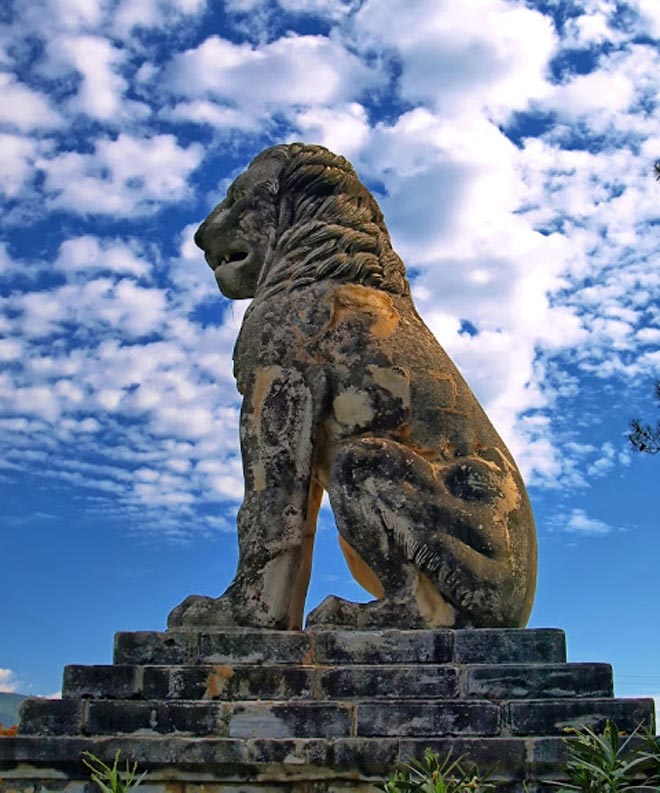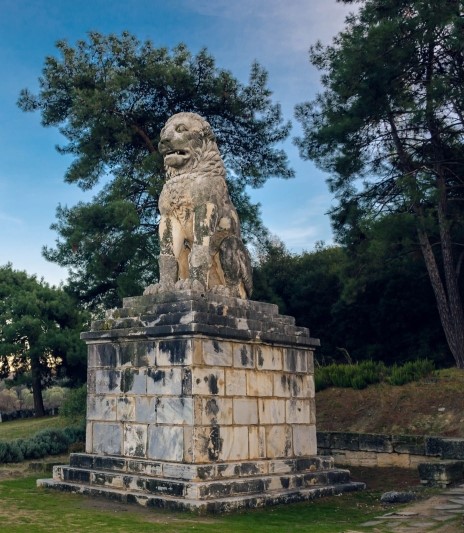

The Lion of Amphipolis – A Timeless Symbol, Guardian of Macedonian Heritage
One of the Most Impressive Monuments in Macedonia
The Lion of Amphipolis is not merely a marble sculpture. It is a powerful symbol that bridges the past with the present—a testament to the glory of ancient Macedonia and the importance of Amphipolis as a strategic, political, and cultural center.As one of the most well-known and striking marble sculptures in Greece, the Lion dominates the landscape near the Strymon River, just a short distance from the Kasta Tomb and the modern village of Amphipolis. It’s the first monument visitors encounter as they approach the area, making a bold statement about its historic significance.
History of the Lion of Amphipolis – When, How, and Why It Was Built
Archaeologists agree that the Lion of Amphipolis dates back to the late 4th century BC or early 3rd century BC, a period of Macedonian prosperity shortly after the death of Alexander the Great. Its construction is likely linked to the commemoration of a prominent individual, perhaps a general or governor, and it symbolizes power, courage, and dominance.One of the prevailing theories is that the monument was erected in honor of Laomedon, one of Alexander the Great’s generals who governed Syria after the eastern campaigns and was buried in the Amphipolis region. Other theories associate the lion with the heroism of Macedonian soldiers or even with the Kasta Tomb itself, which may have housed a member of the royal family.
Excavation and Restoration – The Lion’s Journey Through Time
The lion was not discovered intact. For many years, its fragments lay scattered across the Strymon River area. In the 1930s, Greek and French archaeologists, with the help of the military, undertook the reconstruction of the monument. Over 50 marble pieces were found and used in the restoration, which was completed in 1937. The lion was placed on a 4-meter-high base, while the statue itself stands at 5.3 meters tall.
The result is breathtaking. Its imposing presence, precision craftsmanship, and architectural detail make the Lion of Amphipolis one of Macedonia’s most impressive archaeological landmarks.
What the Lion Symbolizes – More Than a Sculpture
In ancient Greece, the lion was a symbol of authority, bravery, and royal strength. Choosing a lion for an honorary funerary monument was no coincidence—it represented the deceased’s heroic or military status.The lion’s seated posture, with its head turned forward and mouth open, enhances its majestic nature, giving the impression of a guardian eternally watching over the land. For many, the lion serves as a symbolic “welcome” to Amphipolis—an immortal sentinel of Macedonian identity and history.
Visitor Information – Location and Accessibility
The Lion of Amphipolis is located in a convenient spot along the old national road between Kavala and Thessaloniki, just minutes from the Kasta Tomb archaeological site. It is easily accessible by car, with parking available for a short stop.Admission is free, and a visit can be combined with a tour of the Archaeological Museum of Amphipolis, a few kilometers away, which houses authentic findings from the region.
The Lion Today – A Timeless Landmark
The Lion of Amphipolis has become a regional emblem. Beyond its archaeological value, it is a favorite location for photos, educational trips, and a frequent stop for travelers in Eastern Macedonia. Visitors often feel awe in front of its size and meaning, and its proximity to other points of interest—such as Ofrynio Beach, Stavros, or the Kasta Tomb—makes it perfect for a half-day tour or part of a longer excursion.
Why You Should Visit
The Lion of Amphipolis is not just an ancient monument. It’s a living piece of Macedonian history, a symbolic landmark that withstands the test of time and continues to fascinate. If you appreciate history, art, and the grandeur of Greek culture, then a visit to the Lion of Amphipolis is an unmissable experience.

